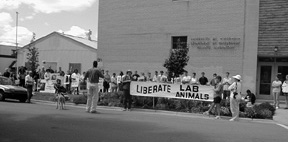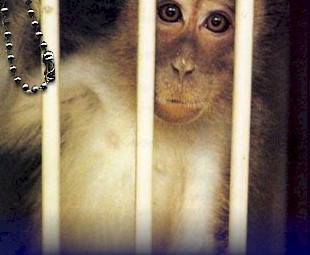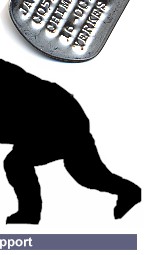Wisconsin National
Primate Research Center
Thinking
of a career at the Univ. of Wisconsin? Read about Dr. Kim Bauers
and her experience as an Asst. Scientist at the Wisc. Primate Research
Center.
Wisconsin
Primate Center's Annual Report for 03/04
Read
about the WRPRC's disqusting behavior
after being caught in eight years of lying to county officials about
monkeys at the Henry Vilas Zoo.
Madison
Newspaper Articles re: Vilas Zoo betrayal
Dalai
Lama Recognizes Cruelty of Wisconsin Primate Center's Ned Kalin
More than a thousand people are wearing Primate Freedom Tags
from the Wisconsin Regional Primate Research Center (WRPRC).
Over 1200 primates including common marmosets, rhesus macaques,
stump-tailed macaques, and cottontop tamarins are experimented on
day in and day out. Wisconsin is not a good place to be if you are
a monkey.
 Photo: Primate Freedom Project Founder,
Rick Bogle, addressing crowd in front of Harlow Lab at WNPRC.
Photo: Primate Freedom Project Founder,
Rick Bogle, addressing crowd in front of Harlow Lab at WNPRC.
The center has been receiving letters and phone calls from Primate
Freedom Tag wearers, who request information about the monkey on
their Primate Freedom Tag. Questions such as: Is he/she still alive?
Is he/she housed alone or with another monkey? How is this monkey
being used? and What are the future plans for this monkey? are only
rarely answered. If you are one of those who have not received answers
to your specific questions, click here
for some suggestions.
WRPRC's public relations director, Jordana
Lenon, has made the claim that those who have written to WRPRC,
simply seeking information on the monkeys being experimented on
there, might be breaking the law
by doing so.
And you, as taxpayers, are paying their
salaries.
See also:
The University of Wisconsin and
the Concept of Honesty
WRPRC Public Relations
WRPRC Vet Files Suit
Below are the types of research being funded by the National Institutes
of Health conducted at the WRPRC. Most researchers (e-mail addresses
provided) are conducting many studies at any one time.
ABBOTT, David H. <ABBOTT@PRIMATE.WISC.EDU>
Abbott creates hormone changes in prenatally androgenized adult
female rhesus macaques. He has discovered that female monkeys develop
pancreatic problems later in life if they are exposed to doses of
male sex hormones when they are fetuses. Now he is giving them daily
injections of increasingly large doses of insulin. He says, "If
our hypothesis is correct, these data will establish that hyperinsulinemia
results in hyperandrogenic anovulation only in prenatally androgenized
female monkeys."
Abbott is also attempting to find a way to increase the birth rate
of marmosets.
AIKEN, JUDD M. <JMA@AHABS.WISC.EDU>
The aging of skeletal muscles in rhesus macaques was Aiken's focus
only a year ago. Now he has a study underway titled, CARDIAC ABNORMALITIES
AND CALORIC RESTRICTION.
ALLEN, TODD M. <TALLEN@PRIMATE.WISC.EDU>
Immune system studies in cotton top tamarins (No current funded
studies.)
AZEN, EDWIN A. <azen@vms2.macc.wisc.edu>
Azen says, "The specific aim is to determine the conditions
for primary cell culture of Macaque and human salivary gland epithelial
cells . . . Perhaps this may lead to a better understanding of salivary-type
gene regulation, and the principles so- derived might be used to
manipulate and favorably alter the oral microenvironment in ways
conductive to oral health. . . . We have two specific aims: a. To
prove directly by transgenic mouse experiments the role of salivary
and von Ebner's gland secreted PRPs in the perception of bitter
taste. . . . b. To establish a taste cell-specific cDNA library
in the mouse as an important resource in identifying molecules that
play a role in transducing taste. These studies may increase understanding
of the relationships between the chemical senses and the oral environment."
Meet Ed!
BAVISTER, B.D. <BDB@AHABS.WISC.EDU>
Bavister has at least six funded projects underway. He is studying
cows, trying to keep hamster embryos alive outside their mothers,
and trying to figure out how to take time-lapse photographs of developing
hamster and monkey embryos being grown in dishes. Apparently, the
light needed to illuminate them for the photographs keeps killing
them. His long term goal is to increase human fertility; 6 billion
people is simply not enough. Note: Boatman, listed below, worked
in Bavister's lab while she was a grad student. Inside sources claim
that their romance led to Boatman being listed as a PhD. working
in Bavister's lab on federal research grant applications even though
she had not yet received this degree. Other sources also suggest
that when the Primate Center director learned of this fraud, he
took immediate steps to hide the misrepresentaion and to hurry Boatman's
degree along. The veracity of these claims has not been verified.
BERCOVITCH, FRED B. Fred has discovered that sexual success in male
rhesus macaques varies between groups of monkeys. He also says that
among the young males he has observed, the most sexually precocious
male sired the most offspring.
BINKLEY, NEIL C. <NBINKLEY@FACSTAFF.WISC.EDU>
Binkley has seven funded projects going. In one he purports to be
studying links between vitamin K and bone; he is using monkeys and
rats in this study, but oddly, is utilizing a chemical called warfarin
which is commonly used in rat poison. In another study, he writes,
"Reduction of calcium intake to 0.15% does not increase markers
of skeletal turnover [in rhesus monkeys.] Note: 0.15% of what he
does not say; normal intake? And, maybe he means 15% instead of
0.15%?
BOATMAN, D.E. <BOATMAN@PRIMATE.WISC.EDU>
Dorothy has been interested in the development of in vitro fertilization
in rhesus macaques and has recently turn her attention to the hormonal
"glue" which binds sperm and egg.
BOYSON, JONATHAN E. Boyson has moved to Harvard. At Wisconsin he
studied fetal-maternal immune interactions in rhesus macaques. Note:
When researchers conduct experiments on animals they are supposed
to conduct a literature search. This is claimed to reduce redundancy
and reduce the number of animals used in federally funded experimentation.
One of the accepted sources for such a search is the CRISP data
base, but increasingly, the CRISP is failing to report meaningful
data. Boyson has a currently funded study titled HLA-G AND NK RECEPTOR
INTERACTIONS IN TROPHOBLAST listed in the CRISP, but the listing
contains no data. This means that someone doing similar research
would have no way to find out about Boyson's through this federal
system. This is counter to the entire notion of collegial endeavor.
CEFALU, W.T. The effect of hunger on induced high serum cholesterol
levels in rhesus macaques
COE, CHRISTOPHER L. <CCOE@FACSTAFF.WISC.EDU>
Coe has six funded studies underway. He writes, "Prior research
by our laboratory has demonstrated that stressful events experienced
by the pregnant female monkey can affect her fetus and alter the
development of several important immune responses in her young infant.
The proposed studies will further investigate the relative vulnerability
of the fetus by assessing the long-term effects of prenatal disturbance
on immune responses and disease susceptibility during the first
year of life." Meet
Chris!
DEYOE, EDGAR A. <deyoe@mcw.edu>
Deyoe, new to the WRPRC writes, "The long range goal of this
Project is to use functional magnetic resonance imaging (FMRI) to
identify the brain mechanisms [in monkeys and humans] responsible
for normal vision and for brain-related visual pathologies. Meet
Edgar!
EMERSON, CAROL L. Emerson conducted a study to determine whether
a particular chemical added to monkey chowmight reduce dental calculus
and plaque. It did.
FRENCH, JEFFREY A. <jfrench@unomaha.edu>
French is studying parenting and parenting assistance in male marmosets.
He appears to be progressing noninvasively by studying hormones
present in urine and through direct observation. Jeff's
homepage!
GOLOS, THADDEUS G. <GOLOS@PRIMATE.WISC.EDU>
Thad is conducting nine studies. He had been studying maternal-fetal
transmission of SIV in rhesus macaques but has broadened his studies
to experiment on the placental fetal/maternal barrier. He notes
that the things he plans for pregnant monkeys would be impossible
[read illegal] to do to humans.
HOKIN, LOWELL E. <HOKIN@MACC.WISC.EDU>
"In collaboration with Dr. Ei Terasawa at the Primate Center,
glutamate release in cerebral cortex of unanesthetized and unstressed
rhesus monkeys will be measured in vivo by push-pull perfusion and
by microdialysis in the presence and absence of lithium." This
is the final year of this 20 year study.
KALIN, NED H. <NKALIN@FACSTAFF.WISC.EDU>
Kalin has six studies underway. In one he writes, "The overall
objective of the proposed research is to understand the neural systems
underlying the expression of emotion in primates. We have focused
on elucidating mechanisms underlying the expression of fear and
anxiety." In another he says, "Preliminary data suggests
that [17] amygdala lesioned animals may be engaging in sleep associated
with less awakenings and longer REM periods." Meet
Ned! Check out the Dalai
Lama's opinion of Kalin's work.
KAUFMAN, PAUL L. <KAUFMANP@MACC.WISC.EDU>
Eight studies underway. In a 25 year study he electrically stimulates
freshly amputated rhesus macaque eyes. In another study he cuts
out monkeys' irises and implants electrodes into their eyes to explore
how monkeys' eyes age. In other studies he surgically mutilates
their eyes in numerous ways, sometimes shocking areas of their brains
to induce vision abnormalities and then administers various drugs
to them to assess their effects.
KEMNITZ, JOSEPH W., (Director) <KEMNITZ@PRIMATE.WISC.EDU>
Energy balance and insulin sensitivity in rhesus macaques. "We
surgically placed cannulas [a flexible metal tube] in the left cerebral
ventricle [the brain] of all animals, to allow direct injection
of leptin next to areas of the brain containing leptin receptors.
We measured food intake and energy expenditure in the monkeys following
intra-cerebral ventricle (ICV) injections or intravenous (IV) injections
of leptin. ICV injections resulted in a dramatic dose-dependent
decrease in food intake." It appears that Kemnitz's career
is being spent looking for ways to increase a macaque's life span
by reducing its food intake and looking for drugs to reduce obesity.
Meet Joe!
Be sure to check out Kemnitz's recent
claims about the monkeys at WRPRC.
Kemnitz deserves to hear from you more than any other researcher
on this page. It is not so much that his research is any more cruel
than any one else's, it's just typically cruel. Joe is a standout
because he was the University of Wisconsin's front man during the
Vilas affair. Of course, he took his orders directly from the graduate
school dean, Virginia
Hinshaw. Together, they and a few of their cronies at WRPRC
made sure that the zoo
monkeys would disappear into the research labs at Tulane University.
Hell, contact them both.
KNECHTLE, STUART J. <stuart@tx.surgery.wisc.edu>Knechtle,
a new face at WRPRC appears to be working on a project similar to
Watkin's kidney transplant experiments. It could even be the same
project, or maybe neither is aware of what the other is doing as
occasionally happens in these cloistered facilities. Meet
Stuart!
KRAEMER, GARY W. <GKRAEMER@SOEMADISON.WISC.EDU>
Kraemer studies various effects of removing rhesus macaque infants
from their mothers. His current study is titled: EFFECTS OF JUVENILE
EXPERIENCE ON MATERNAL PSYCHOBIOLOGY.
LAUGHLIN, N.K. <LAUGHLIN@PRIMATE.WISC.EDU>
Nellie studies lead poisoning in rhesus macaques. "Work during
the previous grant period revealed significant and persistent effects
on auditory function in a nonhuman primate model (the rhesus monkey)
of childhood lead exposure. . . These effects represent enduring
and probably irreversible effects on nervous system function since
the monkeys were 11-13 years old at the time of testing. Lead exposure
was during early development and body burdens of lead had been at
undetectable levels for many years at the times of these evaluations."
LUBACH, GABRIELE R. <LUBACH@PRIMATE.WISC.EDU>
Lubach is studying Purina Monkey Chow's effect on anemia in rhesus
macaques. She reports, "[a] subset of infant monkeys have been
found to manifest signs of IDA [iron-deficient anemia], when born
to females who consumed standard monkey chow diets while pregnant."
It would be reasonable to suppose that nearly all the monkeys have
been fed on standard monkey chow throughout the years. This begs
the questions: Didn't anyone notice that infants were developing
IDA previously? And, what does it mean to the veracity of the facility's
past research data if some of the animals being experimented on
were suffering from IDA?
LUKASHEVICH, IGOR S. Lukashevich explains, "Lassa fever virus
in Africa and Machupo virus in Bolivia are two arenaviruses that
have caused noteable outbreaks in the last few years. . . . we propose
a pilot study to extend our murine mucosal studies to the nonhuman
primate. After intragastric inoculation of rhesus macaques we will
collect information about the level and distribution of virus, the
timecourse of immune responses, and the progression of pathology.
We will employ LCMV [lymphocytic choriomeningitis virus] infection
of monkeys, which strongly resembles Lassa fever virus infection
of monkeys." But LCMV is not Lassa fever, so Lukashevich's
intial sentence is very misleading.
MALKOVSKY, MIROSLAV <MMALKOVS@FACSTAFF.WISC.EDU>
Mr. Malkovsky infects rhesus macaques with SIV.
PAUZA, C. DAVID <CDPAUZA@FACSTAFF.WISC.EDU>
Pauza infects rhesus macaques with SIV. He has eleven funded studies
underway. In one study he is examining the brains of monkey who
exhibited dementia before they died of SIV. In another study he
is messing around with SHIV, that designer retrovirus created by
primate researchers which is a "hybrid" of SIV and HIV.
PUGH, THOMAS D. <TDPUGH@FACSTAFF.WISC.EDU>
Pugh is looking into the effects of hunger on mitochondrial DNA
in rhesus macaques. His five year funding is ending this year, and
he seems to have accomplished very little.
RAMER, JAN C. <JRAMER@PRIMATE.WISC.EDU>
Ramer is searching for causes for the high mortality in WRPRC's
common marmoset colony. Jan is a veterinarian and was an outspoken
advocate for sending the zoo
monkeys to Louisiana.
RAMSEY, JON J. Ramsey is another WRPRC scientist trying to determine
whether hunger in rhesus monkeys might make them live a little longer.
SALTZMAN, WENDY <SALTZMAN@PRIMATE.WISC.EDU>
Social effects of ovarectomy in common marmosets. "Subjects
will be 24 adult female common marmosets, each of which will be
pair-housed with a vasectomized male and will initially be undergoing
regular ovulatory cycles. Twelve animals will undergo ovariectomy
at 4-6 years of age, and the remaining twelve will serve as intact
controls." Wendy has written that female marmosets do not suffer
bone loss after their ovaries are removed as do humans and many
other species. She suggests that exploring this difference may lead
to some sort of treatment for osteoporosis in women. Maybe, but
this is like studying bats' wings and hoping to discover a cure
for carpel tunnel syndrome.
SCHATTEN, GERALD <Schatten@ohsu.edu>
Shatten has twelve funded studies underway, but notice his email
address. Only two of these studies list his address as WRPRC. He
is searching for similarities between human and rhesus reproduction,
but he has recently turned his attention to cloning. He is excited
by the prospect of cloning. He writes, "Furthermore, spontaneous
mutations resulting in unique animals to investigate diseases (e.g.,
retinitis pigmentosa) are periodically discovered in NHP colonies,
and the ability to propagate these animals is vital for future investigations."
It is of note that he has an interest in cloning animals with genetic
illnesses, thereby creating an endless stream of identically suffering
animals.
SCHNEIDER, MARY L. <SCHNEIDER@SOEMADISON.WISC.EDU>
"This research will investigate whether low-level ethanol and/or
psychological stress exposure constitutes a danger to the developing
fetus and what long-term effects emerge in and/or extend to adolescence."
Schneider began poisoning monkeys with alcohol in 1995. She says,
"Studies will determine (1) whether a sensitive period exists
for the prenatal stress effect; (2) whether there are interactional
effects of prenatal stress with maternal emotionality and maternal
exposure to alcohol; and (3) whether the effects persist into adolescence."
Sixth grade students can answer these questions. Who couldn't? How
can she write,"Prenatal alcohol exposure may be one of the
factors contributing to the etiology of developmental disabilities,
either alone or in conjunction with stress. Our data have indicated
that offspring of prenatal alcohol-exposed females show attentional
and neuromotor impairments during early life in comparison to control
infants."? and how can any institution support such unenlightened
archaic research?
SCHRAMM, R.D. Schramm writes, "These results have important
implications in understanding the molecular causes of developmental
failure in primate embryos and in the production of cloned and/or
transgenic primate embryos by nuclear transfer technologies."
SKOLNICK, ALEXANDER J. "Experiment 3 will investigate the role
of affective style in both humans (with self-report scales) and
monkeys (with a paradigm measuring fear-related temperament). Finally,
the role of the amygdala underlying these variables will be examined
through functional brain imaging in humans and lesion studies in
rhesus monkeys taking advantage of data from ongoing studies."
SNOWDON, CHARLES T. <SNOWDON@MACC.WISC.EDU>
Snowdon roposes an improvement of human parenting by studying pygmy
marmosets. He says, "These species have social systems much
more similar to human families than most other primate species,
and the results of these studies should increase our understanding
of factors affecting successful development of human infants."
Snowdon seems to know little about the monagamous species of monkey
or even the African apes.
STRIER, K.B. <KBSTRIER@FACSTAFF.WISC.EDU>
Karen is pursuing a field study of muriqui monkeys in Brazil.
TANNENBAUM, P.L. "We successfully developed a push-pull perfusion
technique to characterize gonadotropin-releasing hormone (GnRH)
release in conscious female marmosets while simultaneously sampling
luteinizing hormone (LH) from an indwelling jugular catheter."
TERASAWA, EI <terasawa@primate.wisc.edu>
Terasawa has a dozen funded studies in place at the moment and focuses
on the effects of brain disruptions on the onset of puberty in rhesus
macaques. Terasawa writes, "Thirteen female monkeys (14.4 q
0.3 months of age) were implanted with a stainless steel cannula
into the base of the 3rd ventricle. Seven monkeys received chronic
infusion of bicuculline every 2 h using a small portable infusion
pump at a dose of 1 M gradually increased to 100 M. The remaining
6 monkeys served as controls. Bicuculline infusion dramatically
advanced the timing of puberty. All bicuculline-treated monkeys
started to exhibit an increase in sex-skin swelling by 3-5 weeks
and had very early menarche." This is akin to forcing puberty
on very young children.
THOMSON, J A. "OBJECTIVE: To test various nuclear transfer
strategies to generate genetically identical rhesus monkeys. RESULTS
The role of Dr. Thomson's laboratory in this project is to derive
new rhesus ES cell lines and provide them to the Oregon Regional
Primate Center for nuclear transfer experiments. During 1997, we
began weekly shipments of early passage rhesus ES cell lines, and
derived a new rhesus ES cell line. FUTURE DIRECTIONS We anticipate
that we will derive 6 new rhesus ES cell lines per year and provide
them to the Oregon Regional Primate Research Center."
UNO, HIDEO 19142 Kanatara Way, West Linn, Oregon 97068, USA <huno@teleport.com>
Phone: 503-635-7021 Uno was looking for a big research grant during
the research on baldness in the stumptail macaques who were housed
at the zoo. Now that that prospect has not panned out, Uno's new
research focus is a comparison of male vs. female rhesus monkey
brains. The early reports suggest males have larger brains but the
data from four of the center's experimental "pseudohermaphrodite
female monkeys" has yet to be evaluated.
VER HOEVE, JAMES N. Writes, "[w]e have completed an extensive
survey of sweep visual-evoked potential (VEP) and pattern electroretinographic
(PERG) acuity in all available old (21 to 31 years) rhesus monkeys
at the Wisconsin Regional Primate Research Center. The survey included
110 tests from 58 animals (31 young and 27 old). Both cortical (VEP)
and retinal (PERG) acuity was significantly lower in the old monkeys.
As predicted on the basis of human studies, there was a large overlap
in the range of visual acuities at optimal refraction between old
and young monkeys." [emphasis added] This is the standard fare
at the primate centers: base research on what is already known in
humans. This is the reverse of the rationales used to justify the
continuation of these facilities. Meet
James!
WATKINS, DAVID I. <WATKINS@PRIMATE.WISC.EDU>
Watkins is listed as the Principle Investigator on ninteen currently
funded studies. He studies gene sequencing in primates, induced
SIV in rhesus macaques, and writes that destruction of a monkey's
immune system will make it less likely to reject a transplanted
kidney.
WEINDRUCH, RICHARD H. <RHWEINDR@FACSTAFF.WISC.EDU>
The effects of hunger on longevity in rhesus macaques. "Cohort
1: the monkeys now under study (n=14/group, males). We will add
Cohort 2: n=15/group, 8-14 yr old females to be followed as per
Cohort 1, and Cohort 3: n=8/group, 8-14 yr old males also undergoing
biopsy of liver, spleen and skeletal muscle." Weindruch has
quit posting gruesome details of his work on the CRISP, but does
have a study listed in which he says, "We have also developed
a strategy to recruit minority students and post-doctoral fellows
and a rigorous approach to exposure and discussion of issues in
bioethics." Bioethics and the Primate Center? Oxymoronic.
WEINREB, ROBERT N.: Weinreb observes the effects of various chemicals
on intraocular pressure in rhesus monkeys' eyes. Currently he is
trying to figure out just how a mediction used in humans to reduce
intraocular pressure works. To do this he treats the monkeys with
the drug, then he kills them and dissects their eyes. Meanwhile,
the drug has been in use for humans for years. Meet
Robert!
WILEY, JOHN D. The CRISP entry for Wiley lists no data other than
a grant title: NATIONAL INSTITUTE ON AGING (NIA): AGING COLONY MAINTENANCE.
Apparently he has been given control of a monetary fund to make
sure there are old monkeys on hand for the vivisectors.
ZIEGLER, TONI E. <ZIEGLER@PRIMATE.WISC.EDU>
Ziegler was studying the effects of testosterone injections on male
cotton top tamarins, but seems to have moved to less invasive investigations.
He is working on the marmoset reproduction problems being encountered
at the primate centers and is working with Strier on the muriqui
monkey project in Brazil.
Researcher Showcase
Kalin, M.D., Ned
M.D. 1976, Jefferson Medical College
Professor and Chair
Department of Psychiatry
6001 Research Park Blvd.
Madison, WI 53711
Phone: (608) 263-0491
nkalin@facstaff.wisc.edu
"My research is focused on understanding the neurobiological
basis of fear and anxiety. To accomplish this we use a variety
of rodent and non-human primate models. Most recently we have
been focusing on the developmental aspects of fear and anxiety,
asking questions related to individual differences early in life
and how they predict later development and expression of psychopathology.
Specifically, we assess behavior, electrophysiological parameters,
hormonal measurements and the expression of specific genes related
to stress. In addition, we directly manipulate brain systems such
as the amygdala. Studies in primates are ongoing which involve
excitoxin lesion of the amygdala, site-specific administration
of glutamate, GABA, and CRF ligands as well as push-pull perfusion.
These studies address the role of select neurotransmitter systems
in the amygdala in mediating fear and anxiety."
REPRESENTATIVE PUBLICATIONS
Kalin N.H., Shelton, S.E., Lynn, D.E. (1995). Opiate Systems in
Mother and Infant Primates Coordinate Intimate Contact During
Reunion. Psychoneuroendocrinology, 20(7): 735-742
Kalin, N.H., Takahashi, L.K., & Chen, F.L. (1994). Restraint
Stress Increases Corticotropin Releasing Hormone mRNA Content
in the Amygdala and Paraventricular Nucleus. Brain Research, 656,
182-186.
Kalin, N.H. (1993). The Neurobiology of Fear. Scientific American,
268(5), 94-101.
Kalin, N.H., Shelton, S.E. (1989). Defensive behaviors in infant
rhesus monkeys: Environmental cues and neurochemical regulation.
Science, 243, 1718-1721.
Home Page | Our Mission | News
What Are Primate Freedom
Tags | Order Tag
Primate Research
Centers | Resources
|







 Photo: Primate Freedom Project Founder,
Rick Bogle, addressing crowd in front of Harlow Lab at WNPRC.
Photo: Primate Freedom Project Founder,
Rick Bogle, addressing crowd in front of Harlow Lab at WNPRC.